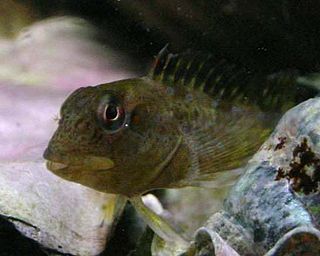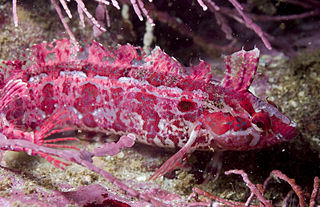
Istiblennius is a genus of combtooth blennies found in the Pacific and Indian Oceans. The generic name is a compound noun composed of istio the Greek for "sail", referring to the high dorsal fin of the type species, Istiblennius muelleri, and blennius which is derived from a word for "mucus" and refers to the scaleless bodies that characterise the Blenniidae.

Lipophrys is a small genus of combtooth blennies found in Atlantic ocean and the Mediterranean Sea. It is one of 57 genera in the family Blenniidae. The generic name is made up of the Greek words lipo meaning "want" or "absence" and phrys meaning "eyebrow" referring to the lack of any cirri over the eyes in the type species L. pholis.
Rhabdoblennius is a genus of combtooth blennies found in the Pacific Ocean, mostly in the western Pacific. The name pf this genus is derived from the Greek word rhabdos meaning "stick" or "rod" and blennius meaning "mucus", referring to the absence of scales on the body of blennies.

Emblemariopsis diaphana, the glass blenny, is a species of chaenopsid blenny found in coral reefs in the Florida Keys, USA, in the western central Atlantic ocean. It can reach a maximum length of 4 centimetres (1.6 in) TL. The specific name refers to this species being "largely translucent" in life, although this is lost in preserved specimens. E. diaphana is the type species of the genus Emblemariopsis.
Neoclinus stephensae, the Yellowfin fringehead, is a species of chaenopsid blenny found in the eastern Pacific ocean. It can reach a maximum length of 10 centimetres (3.9 in) TL. The specific name honours the collector of the type, the British-American conchologist Kate Stephens who was Curator of Mollusks and Marine Invertebrates at San Diego Natural History Museum and who was over 100 years old at the time the species was described.

Gibbonsia is a genus of clinids native to the eastern Pacific ocean. The name of this genus honours the American naturalist, physician and founder member of the California Academy of Sciences, William P. Gibbons (1812-1897).
Malacoctenus hubbsi, the redside blenny, is a species of labrisomid blenny native to the Gulf of California extending to the Pacific coast of southern Baja California. It is found in rocky areas at depths of from 1 to 4 metres. This species can reach a length of 9 centimetres (3.5 in) TL. The specific name honours the American ichthyologist Clark Hubbs (1921-2008).
Paraclinus walkeri, the San Quintin blenny, is a species of labrisomid blenny native to the coasts of Baja California Sur, Mexico. The specific name honours the fisheries biologist Boyd W. Walker (1917-2001) of the University of California, Los Angeles who placed his specimens at the disposal of Clark Hubbs.
Helcogramma ememes is a species of triplefin blenny in the genus Helcogramma. It was described by Wouter Holleman in 2007 who used the initials of his mentor Margaret Mary Smith (1916-1987) of the J.L.B. Smith Institute of Ichthyology to create this species specific name. Smith and her husband, J.L.B. Smith, had collected many specimens of this blenny in the 1960s. This species is found in the western Indian Ocean along the coats of East Africa from the Bazaruto Islands in Mozambique to Malindi in Kenya, it is also found in the Comoro Islands, Mauritius and the Seychelles.

Helcogramma hudsoni, known commonly as the Hudson's triplefin, is a species of triplefin blenny in the genus Helcogramma. It was described by David Starr Jordan and Alvin Seale in 1906, the specific name honouring the illustrator of their monograph on Samoan fishes, R.L. Hudson. This species is found in the western Pacific Ocean where it has been recorded from the Izu Islands, Ryukyu Islands, Savo Island, New Caledonia, Vanuatu, Fiji, and Samoa.
Helcogramma randalli, Randall's triplefin, is a species of triplefin blenny in the genus Helcogramma. It was described by Jeffrey T. Williams and Jeffrey C. Howe in 2003 and named it in honour of the ichthyologist John Ernest Randall of the Bishop Museum in Honolulu who collected all of the known specimens. This species occurs in the western Pacific Ocean and is endemic to the islands of central Indonesia such as Bali, Lombok, Timor and Komodo.
Helcogramma rharhabe is a species of triplefin blenny in the genus Helcogramma. It was described by Wouter Holleman in 2007, the specific name the Xhosa chief Rharhabe who broke away from his main tribe and formed his own grouping named after him, the Rharhabe. This species is found in the western Indian Ocean, along the south eastern coast of Africa from the Transkei to the Bazaruto Archipelago.
Helcogramma serendip is a species of triplefin blenny in the genus Helcogramma. It was described by Wouter Holleman in 2007. This species is found only around the coasts of Sri Lanka and its specific name references the old Arabic name for Sri Lanka.
Helcogramma springeri, known commonly as the Springer's triplefin, is a species of triplefin blenny in the genus Helcogramma. It was described by P.E. Hadley Hansen in 1986. The specific name honours the ichthyologist Victor G. Springer of the National Museum of Natural History. This species is found in the western Pacific Ocean from Indonesia and the Philippines to northern Australia, including the Great Barrier Reef.
Helcogramma steinitzi, known commonly as the red triplefin, is a species of triplefin blenny in the genus Helcogramma. It was described by Eugenie Clark in 1980. The specific name honours the marine biologist and herpetologist Heinz Steinitz (1909-1971) of the Hebrew University, Jerusalem. This species occurs in the north western Indian Ocean from the Red Sea to the Persian Gulf.
Cunningham's triplefin is a species of triplefin blenny in the genus Helcogrammoides. It was described by Frederik Adam Smitt in 1898, who named it in honour the Scottish naturalist Robert Oliver Cunningham (1841-1918), who had collected specimens of this fish from Puerto Madryn in 1868 but was unable to identify them. This species has been found in Peru, near Lima, Chile, Puerto Madryn in Argentina and the Falkland Islands.
Lepidonectes clarkhubbsi, known commonly as the signal triplefin, is a species of triplefin blenny in the genus Lepidonectes. It was described by William Albert Bussing in 1991 and he gave it a specific name which honours the American ichthyologist Clark Hubbs (1921–2008). This species occurs in the eastern Pacific Ocean where it is found off Costa Rica and Panama. The signal triplefin is found on rocky shores where it feeds on very small invertebrates and algae.

Norfolkia squamiceps, known commonly as the Scalyhead triplefin, is a species of triplefin blenny in the genus Norfolkia. It was described by Allan Riverstone McCulloch and Edgar Ravenswood Waite in 1916. Under the synonym Norfolkia lairdi it was the type species of Fowler's new genus. This species has been recorded from off Queensland, Norfolk Island, Lord Howe Island, New Caledonia and the Loyalty Islands. The adults occur in tidal pools among areas of coral reef.
Springerichthys kulbickii, known commonly as the Kulbicki's triplefin, is a species of triplefin blenny in the genus Springerichthys. It was described by Ronald Fricke and John E. Randall in 1994, honouring the fish ecologist reef-fish ecologist Michel L. Kulbicki of L'Office de la Recherche Scientifique et Technique d’Outre-Mer in Nouméa, who collected type in New Caledonia, in its specific name. Kulbicki's triplefin is found in the southwestern Pacific Ocean from Queensland, Australia across the central Pacific to the Samoa, where it is found on rocky and coral reefs down to 15 metres (49 ft) in depth.

Helcogramma williamsi is a species of triplefin blenny in the genus Helcogramma which is widespread in the western Pacific Ocean. It is found in rocky areas with sandy channels at depths of 1 to 3 metres It was described in 2012 from a type collected from Taiwan. The specific name honours the ichthyologist Jeffrey T. Williams of the Smithsonian Institution.






